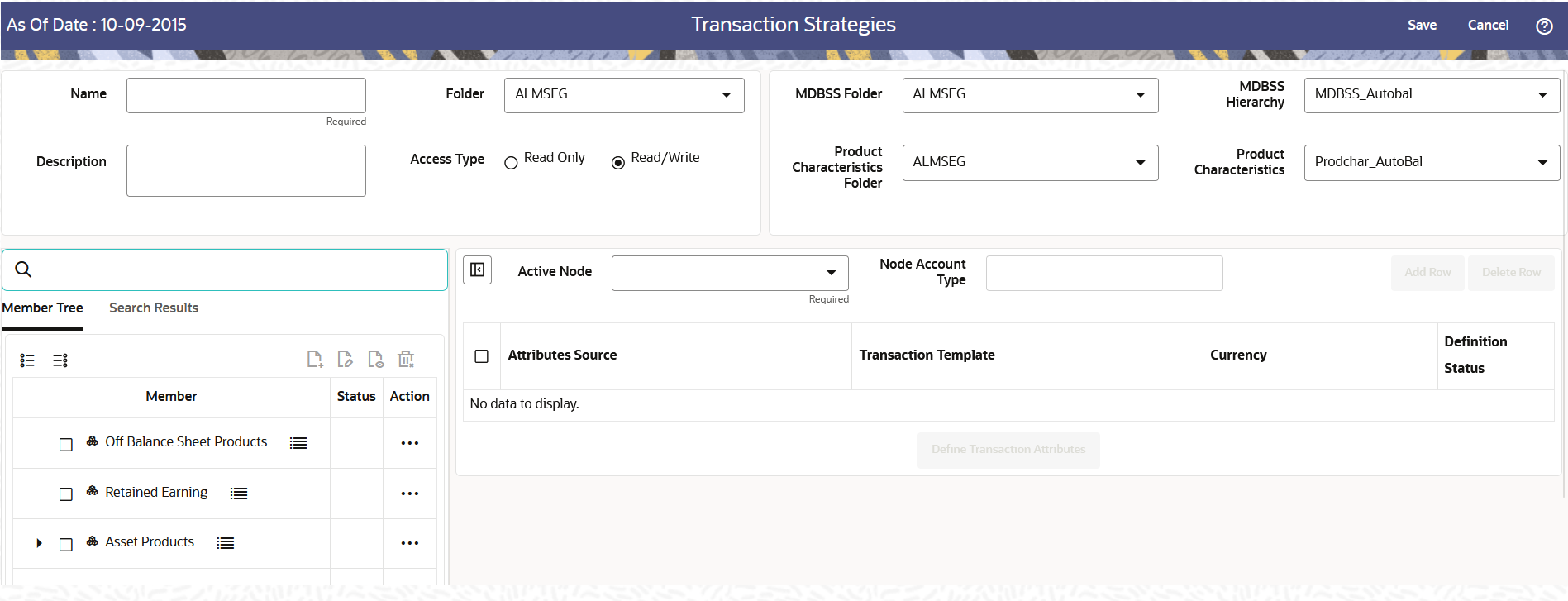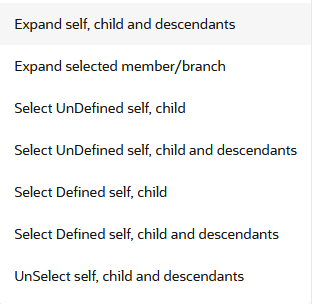5.3.2.6.1 Create Transaction Strategy Rules
You create a Transaction Strategy Rule to define Transaction Strategy assumptions.
To create a new Transaction Strategy Rule, follow these steps:
- Click Add icon from the top of the Transaction Strategy Rule
Summary page. The Transaction Strategies window is displayed:
Figure 5-189 Transaction Strategy Rule

- Enter the following Details.
- Name: Enter the name of the Transaction Strategy Rule.
- Description (optional): Enter the description of the Transaction Strategy Rule.
- Folder: Select the Folder where the Transaction Strategy Rule needs to be saved.
- Access Type: Select the Access Type as Read-Only or Read/Write.
- Select a MDBSS Folder and MDBSS.
- Select Product Characteristics Folder and Product Characteristics.
- Select MDBSS Node(s) from Member Tree of Assumption Browser. The
Assumption Browser has following two tabs: Member Tree and Search Results.
Note:
MDBSS is enabled only in ALM Cloud Service.If any member is a currency in the MDBSS hierarchy (for example, INR) and selected currency is different (for example USD), then the member and its children nodes cannot be defined.
- Member Tree: Member Tree tab shows the hierarchical structure
and allows you to define rules by selecting the node members from the
browser. Select Node and Click Menu icon next to it to view the available
options.
Figure 5-190 Member Tree

Status of node is also displayed in Member Tree section, for example Selected, and so on. To select member hierarchy, following options are available:
- Expand self, child and descendants: Allows to expand the selected node itself along with its child and descendants.
- Expand selected member/branch: Allows to expand the selected node
- Select UnSelect self, child: Allows to unselect the selected node itself along with its child
- Select UnSelect self, child and descendants: Allows to unselect the selected node itself along with its child and descendants.
- Select Defined self, child: Allows to select the selected node itself along with its child.
- Select Defined self, child and descendants: Allows to select the selected node itself along with its child and descendants.
- UnSelect self, child and descendants: Allows to unselect the selected node itself along with its child and descendants.
Use Show Numeric Code Values (Left) icon to view the code value left to the Node name.
Use Show Numeric Code Values (Right) icon to view the code value right to the Node name.
Here, you can perform the following tasks on the selected node(s):
- Add
- Edit
- View
- Delete
- Copy
- Search Results: You can also search the members based on
the filters. This section shows the searched node(s). To search a member,
follow these steps:
- Navigate to Assumption Browser section of the Rule Definition page.
- Enter the Member ID, Name, Status, or Is Leaf in Search
Criteria.
Figure 5-191 Search Criteria

- Click Search. The searched member(s) will be
displayed in Search Results section of Assumption
Browser.
Figure 5-192 Searching Members

Here, you can perform the following tasks on the searched node(s):
- Add
- Edit
- View
- Delete
- Copy
Click Show Parentage icon to view the Parent-child Node level hierarchy details of selected Node.
Use Show Numeric Code Values (Left) icon to view the code value left to the Node name.
Use Show Numeric Code Values (Right) icon to view the code value right to the Node name.
- Member Tree: Member Tree tab shows the hierarchical structure
and allows you to define rules by selecting the node members from the
browser. Select Node and Click Menu icon next to it to view the available
options.
- Click Add from Assumption Browser Section. For more information, see the Defining Transaction Strategy Methodologies.
- Click Save.